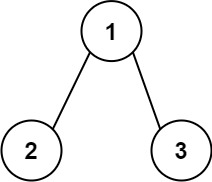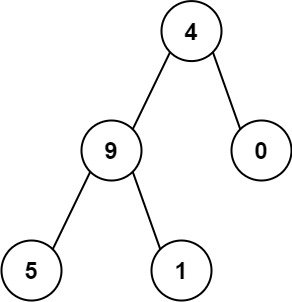Sum Root to Leaf Numbers
MediumYou are given the root of a binary tree containing digits from 0 to 9 only.
Each root-to-leaf path in the tree represents a number.
- For example, the root-to-leaf path
1 -> 2 -> 3represents the number123.
Return the total sum of all root-to-leaf numbers. Test cases are generated so that the answer will fit in a 32-bit integer.
A leaf node is a node with no children.
Example 1:

Input: root = [1,2,3] Output: 25 Explanation: The root-to-leaf path1->2represents the number12. The root-to-leaf path1->3represents the number13. Therefore, sum = 12 + 13 =25.
Example 2:

Input: root = [4,9,0,5,1] Output: 1026 Explanation: The root-to-leaf path4->9->5represents the number 495. The root-to-leaf path4->9->1represents the number 491. The root-to-leaf path4->0represents the number 40. Therefore, sum = 495 + 491 + 40 =1026.
Constraints:
- The number of nodes in the tree is in the range
[1, 1000]. 0 <= Node.val <= 9- The depth of the tree will not exceed
10.
Solution
Clarifying Questions
When you get asked this question in a real-life environment, it will often be ambiguous (especially at FAANG). Make sure to ask these questions in that case:
- What is the range of values that the nodes in the tree can hold? Can they be negative?
- Can the tree be empty or contain only a single node?
- What should I return if the root is null (empty tree)? Should I return 0?
- Are the node values guaranteed to be single digits (0-9), or can they be larger?
- By 'root-to-leaf' path, do you mean a path starting from the root and ending at a leaf node (a node with no children)?
Brute Force Solution
Approach
The brute force strategy involves exploring every single path from the top of the tree to the bottom. For each path, we'll construct a number and then add up all the numbers to get our final answer. It's like trying every route in a maze to find all the possible end points.
Here's how the algorithm would work step-by-step:
- Start at the very top of the tree.
- Go down every possible path from the top to a leaf (the bottom of the tree).
- As you go down each path, build a number by adding the value of each node you visit to the end of your number.
- Once you reach a leaf, you have a complete number for that path.
- Add that number to a running total.
- Repeat this process for every single path from the top to a leaf.
- When you've explored every path and added all the numbers, the running total is your final answer.
Code Implementation
def sum_root_to_leaf(root):
total_sum = 0
def calculate_path_sum(node, current_number):
nonlocal total_sum
if not node:
return
# Build the number as we traverse down the tree
current_number = current_number * 10 + node.val
if not node.left and not node.right:
# Reached a leaf node, add current number to the total
total_sum += current_number
return
calculate_path_sum(node.left, current_number)
calculate_path_sum(node.right, current_number)
calculate_path_sum(root, 0)
return total_sumBig(O) Analysis
Optimal Solution
Approach
We want to find the total value of numbers formed by paths from the root of a tree down to each leaf. The clever approach involves building up each number step-by-step as we travel down the tree and adding that number to a running total when we hit a leaf.
Here's how the algorithm would work step-by-step:
- Start at the root of the tree with an initial number of zero.
- As you move from a parent node to a child node, update the current number by multiplying it by ten and then adding the child's value.
- If you reach a leaf node (a node with no children), add the current number to a running total.
- Repeat this process for all paths from the root to the leaves.
- The final running total will be the sum of all root-to-leaf numbers.
Code Implementation
def sum_numbers(root):
total_sum = 0
def calculate_sum(node, current_number):
nonlocal total_sum
if not node:
return
# Build number as we traverse.
current_number = current_number * 10 + node.val
# Leaf node condition
if not node.left and not node.right:
total_sum += current_number
return
# Explore left subree.
calculate_sum(node.left, current_number)
# Explore right subtree.
calculate_sum(node.right, current_number)
calculate_sum(root, 0)
# Return accumulated sum
return total_sumBig(O) Analysis
Edge Cases
| Case | How to Handle |
|---|---|
| Null root node | Return 0 if the root is null, as there's no path and thus no sum. |
| Single node tree (root only) | Return the value of the root node itself since it's both the root and the leaf. |
| Tree with very large depth, potentially causing stack overflow with recursion | Consider iterative DFS or BFS to avoid stack overflow errors from excessive recursion depth. |
| Tree with very large numbers, potentially leading to integer overflow when concatenating the path number | Use a larger data type (e.g., long) to store the number, or use modular arithmetic to prevent overflow. |
| Tree with all nodes having the value 0 | The algorithm should correctly sum the paths formed by all zeros (e.g., a path of 0 -> 0 should result in the number 0). |
| Unbalanced tree with highly skewed distribution of node values | The algorithm should handle unbalanced trees efficiently; the performance will be affected by the tree's height, but the correctness will be preserved. |
| Tree containing leading zeros in a path (e.g., 0 -> 1) | The standard approach of building the number concatenating from root to leaf will correctly form the number (e.g., path 0->1 will create the number 1 and not require any special handling). |
| Nodes with negative values (invalid in the problem context but good to clarify) | Clarify with the interviewer whether negative values are allowed, and if so, how to handle them, as the problem description implies non-negative single digit values for each node. |